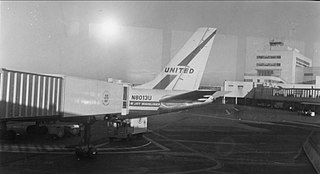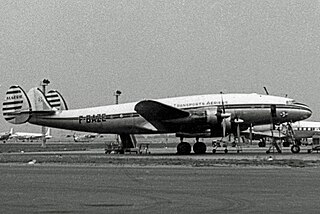Eastern Air Lines, also colloquially known as Eastern, was a major American airline from 1926 to 1991. Before its dissolution, it was headquartered at Miami International Airport in an unincorporated area of Miami-Dade County, Florida.

The Bristol Type 175 Britannia is a retired British medium-to-long-range airliner built by the Bristol Aeroplane Company in 1952 to fly across the Commonwealth. During development two prototypes were lost and the turboprop engines proved susceptible to inlet icing, which delayed entry into service while solutions were sought.

The Boeing 377 Stratocruiser was a large long-range airliner developed from the C-97 Stratofreighter military transport, itself a derivative of the B-29 Superfortress. The Stratocruiser's first flight was on July 8, 1947. Its design was advanced for its day; its relatively innovative features included two passenger decks and a pressurized cabin. It could carry up to 100 passengers on the main deck plus 14 in the lower deck lounge; typical seating was for 63 or 84 passengers or 28 berthed and five seated passengers.

Gander International Airport is located in Gander, Newfoundland and Labrador, Canada, and is operated by the Gander International Airport Authority. Canadian Forces Base Gander shares the airfield but is a separate entity from the airport. The airport is sometimes referred to as the "Crossroads of the World", and is classified as an international airport by Transport Canada.

On December 16, 1960, a United Airlines Douglas DC-8 bound for Idlewild Airport in New York City collided in midair with a TWA Lockheed L-1049 Super Constellation descending toward LaGuardia Airport. The Constellation crashed on Miller Field in Staten Island and the DC-8 in Park Slope, Brooklyn, killing all 128 aboard the two aircraft and six people on the ground. The accident was the world's deadliest aviation disaster at the time.

Kallang Airport was the first purpose-built civil international airport in Singapore, opened officially on 12 June 1937 and ceased operations in 1955, when it was relocated to Paya Lebar. Situated on the eastern shore of the Kallang Basin, the Kallang Airport spanned the modern planning areas of Kallang and Geylang at its greatest extent. The conserved complex, including the airport's terminal building, is located wholly within Kallang.

Air Ceylon was the former flag carrier airline of Ceylon. The airline discontinued flights to Europe in early 1978 and finally ceased all local services on 31 August 1979, when it was replaced by Air Lanka and then rebranded to SriLankan Airlines later.

BOAC Flight 781 (BA781/BOA781) was a scheduled British Overseas Airways Corporation (BOAC) passenger flight from Singapore to London. On 10 January 1954, a de Havilland Comet passenger jet operating the flight suffered an explosive decompression at altitude and crashed, killing all 35 people on board.

South African Airways Flight 201 (SA201), a de Havilland Comet 1, took off at 18:32 UTC on 8 April 1954 from Ciampino Airport in Rome, Italy, en route to Cairo, Egypt, on the second stage of its flight from London, England to Johannesburg, South Africa. The flight crashed at around 19:07 UTC, killing all on board. The flight was operated as a charter by British Overseas Airways Corporation (BOAC) using the aircraft G-ALYY, with a South African crew of seven, and carrying fourteen passengers.
Skyways Limited was an early post-World War II British airline formed in 1946 that soon became well-established as the biggest operator of non-scheduled air services in Europe.
Air France has been in operation since 1933. Its aircraft have been involved in a number of major accidents and incidents. The deadliest accident of the airline occurred on June 1, 2009, when Air France Flight 447, an Airbus A330-203, flying from Rio de Janeiro to Paris crashed into the Atlantic Ocean with 228 fatalities. A selected list of the most noteworthy of these events is given below.

Avianca Flight 671, registration HK-177, was a Lockheed Constellation that crashed and burned on landing at Montego Bay, Jamaica, on 21 January 1960. It was and remains the worst accident in Jamaican aviation history.

Linea Aeropostal Venezolana Flight 253 was a regularly scheduled passenger flight from Idlewild International Airport, New York to Caracas International Airport in Caracas, Venezuela. During the November 27, 1956 operation of the flight, by a Lockheed L-749 Constellation, registration YV-C-AMA and named Jose Marti, the aircraft, piloted by French captain Marcel Combalbert, crashed into a mountain near Caracas, Venezuela. All 25 passengers and crew on board were killed. This occurred just five months after another operation of this flight, with a Lockheed L-1049 Super Constellation, ended with a fatal crash as well.

The 1954 Prestwick air disaster occurred in the early morning of Christmas Day, 1954. A British Overseas Airways Corporation Boeing 377 Stratocruiser crashed on landing at Prestwick Airport, Scotland; 28 of the 36 on board were killed.

On 1 September 1953, an Air France Lockheed L-749 Constellation, registered in France as F-BAZZ, flying Flight 178, a scheduled flight from Paris to Nice, crashed into the Pelat Massif in the French Alps near Barcelonnette on the first stage of the flight, between Orly Airport and Nice Airport. All 42 on board were killed, nine crew and 33 passengers including the French violinist Jacques Thibaud and the French pianist René Herbin.

British Overseas Airways Corporation (BOAC) was the British state-owned airline created in 1939 by the merger of Imperial Airways and British Airways Ltd. It continued operating overseas services throughout World War II. After the passing of the Civil Aviation Act 1946, European and South American services passed to two further state-owned airlines, British European Airways (BEA) and British South American Airways (BSAA). BOAC absorbed BSAA in 1949, but BEA continued to operate British domestic and European routes for the next quarter century. The Civil Aviation Act 1971 merged BOAC and BEA, effective 31 March 1974, forming today's British Airways.

Air France Flight 152 (AF152) was a scheduled international passenger flight which made an emergency water landing in the Mediterranean Sea, off Fethiye, South-Western Turkey on 3 August 1953. The aircraft sank over an hour after ditching. Four passengers died, out of 8 crew and 34 passengers.














